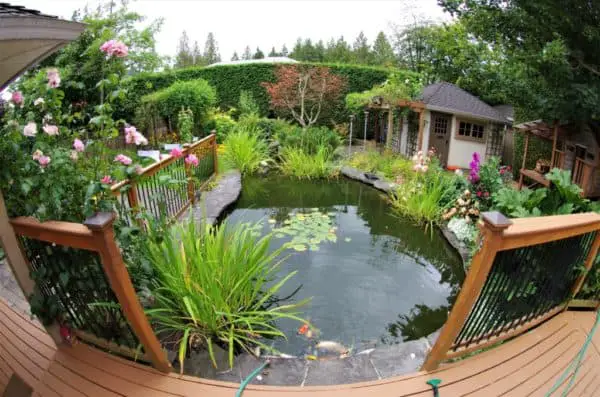You’ve been thinking about building a pond in your backyard. While it sounds nice having the pond up close where you can see it and enjoy it to the fullest, you’re also concerned about having it too close to your home.
Small ponds holding less than 1000 gallons should be kept at a minimum of 50 to 100 feet away from the house to prevent damage to your home. Larger ponds that are greater than 1000 gallons should be kept at a minimum of 100 to 200 feet away to prevent damage to your home.
Knowing how far away to keep your pond is only part of your battle. You’re going to need to know what your local guidelines are for ponds (if any), if you want any fish in your pond, and any other number of things to plan. You might spend just as much time thinking about making your pond as you do in the actual creation of it.
Local Guidelines
While these general guidelines are a good place to start, you should also make sure that there are no local guidelines you need to follow. Building codes and regulations might require you to keep your pond further away from any buildings. Some regulations even have a set distance from any property boundaries and fences. These rules are often based on local weather conditions and climate.
Building Your Pond
When choosing the location to put your pond, you will also want to consider what you are going to be doing with the pond. If it is a fish pond, you may want to keep it in a well-shaded area so that the water temperatures don’t rise too much and fry your fish. Keeping the temperatures regulated is important for keeping fish. As much as you may like fish sticks, your fancy koi are far too expensive to make into food.
At the same time as finding a shaded area, try to avoid being directly under trees and large bushes so that their leaves don’t swamp the water. Just because it’s not a swimming pool doesn’t mean you don’t need to keep your pond clean, and keeping the pond away from falling leaves will make your job that much easier and giving you that much more time to binge-watch your favorite tv show on Netflix.
Once you have found the perfect spot for your pond and have gotten far too emotionally invested in its location, before you can begin digging out the hole for your pond, you will also need to call 811, the national “call before you dig” phone number.
You’ll want to contact them several days before you intend on digging out your pond. This free service allows you to dig without worrying about hitting something that will electrocute you or take out your heat for a month. Unless it’s summertime and you want to take out your gas heating, this is not recommended, but then you’d have bigger problems than your heating not working, namely, a gas leak.
When calling the 811, make sure to tell them your intended project, your address, county, nearest cross street, and where you plan on digging. After waiting several days for all of the utilities to mark their underground lines, you can begin digging.
You may have to reconsider the location of your pond, the size of the pond, or even your life decisions that led you to decide that you wanted to build a pond there in the first place.
Once you finally are able to begin digging out your pond, if you plan on keeping fish in it and you live in an area that reaches below freezing in the wintertime, make sure the pond is at least three feet deep to prevent the water from freezing over. If the pond is for koi or other big fish, you may need to have it even deeper.
After you have your hole, before you can fill it with water, you will need to line your pond with a plastic or rubber liner. You can get these from a home improvement store or a landscaper. Having the liner all in one piece will prevent leakage. Add rocks over the edge of the liner to both hold down the liner, and to create an attractive edge to your pond.
You will then need to fill your pond with water, but before you can do so, you will need to make sure to dechlorinate your water. If your water is simply sanitized with chlorine, you can just fill your pond, allowing for plenty of time for any chlorine to evaporate out before you add your fish to the pond. Be sure to test your water levels before adding your fish.
If your water contains chloramine, you will need to purchase a filter that will remove it because chloramine does not evaporate into the atmosphere like chlorine does.
Dangers of Being Too Close
But I want my pond right next to my house, you may say. What could I possibly risk by having it closer than you have recommended?
Well, besides risking falling in every time you decide to take a stroll out into your backyard and scaring your fish, something you risk by having your pond too close to your house is damaging your foundation.
A pond always has the potential of leaking or flooding, and while the water may seem to have been absorbed harmlessly into the ground, it may begin to seep into the foundation. If this water freezes, it can expand and cause cracks to appear within the foundation. This can lead to problems further down the road.
If you have a basement, you also run the risk of flooding. This can cause lots of damages to carpeting, furniture, and other parts of your home. While a sump pump can help with this, it’s safer just to prevent against this from happening in the first place by keeping the pond further away from the house.

